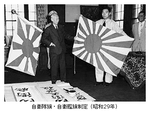- Thread starter
- #21
Navigation
Install the app
How to install the app on iOS
Follow along with the video below to see how to install our site as a web app on your home screen.
Note: This feature may not be available in some browsers.
More options
You are using an out of date browser. It may not display this or other websites correctly.
You should upgrade or use an alternative browser.
You should upgrade or use an alternative browser.
Back in Time to Old Japan (1 Viewer)
- Thread starter Shinpachi
- Start date
Ad: This forum contains affiliate links to products on Amazon and eBay. More information in Terms and rules
More options
Who Replied?BombTaxi
Tech Sergeant
I don't find it offensive, but I am mystified as to why someone would paint it up a decade and a half after the war ended. It suggests to me that the shopkeeper is a neo-Nazi...
- Thread starter
- #23
I don't find it offensive, but I am mystified as to why someone would paint it up a decade and a half after the war ended.
That is exactly what I mean.
- Thread starter
- #25
Hello, Adler.
You don't know how much the old Japanese respected and missed the Germans at all.
To a contrary, your blame may sounds an insult for my fathers/grandfathers even if they had been so ignorant about the postwar situation in Germany.
OK. See this photo.
These two white Japanese G4Ms were called 'Green-cross Betty' missioned for the surrender negotiation but it has been said that the green cross does not look green but black even in the color photos.
It of course does not look green because it was black.
Actual color was reconfirmed by my friend on a relic from other 'Green-cross' Zero fighter.
They would have shown their small resistance to the allies' instruction and respect/mourning to the lost Germany with the black cross.
Adler, I wish you to be some more generous about our ignorance.
We have our own historical background here.
Thanks.
You don't know how much the old Japanese respected and missed the Germans at all.
To a contrary, your blame may sounds an insult for my fathers/grandfathers even if they had been so ignorant about the postwar situation in Germany.
OK. See this photo.
These two white Japanese G4Ms were called 'Green-cross Betty' missioned for the surrender negotiation but it has been said that the green cross does not look green but black even in the color photos.
It of course does not look green because it was black.
Actual color was reconfirmed by my friend on a relic from other 'Green-cross' Zero fighter.
They would have shown their small resistance to the allies' instruction and respect/mourning to the lost Germany with the black cross.
Adler, I wish you to be some more generous about our ignorance.
We have our own historical background here.
Thanks.
Attachments
michaelmaltby
Colonel
Black crosses, green crosses - we know the surrender was surrounded by behind-the-scenes politics, emotions, agendas, disbelief, humiliation, pride and CONFUSION.
The miracle - given how bitterly and desperately these two nations (Britain, Netherlands, Commonwealth included) fought each other and descended to depths of brutality - is that the peace was achieved in an orderly hand-over.
The symbol is only a symbol - judge by actions not symbols. If the"kitchen" store is holding backroom, clandestine neo-Nazis rallies that is one thing; if the owners associate the quality of their German wares with the Reich eagle atop the swastika, that is another. The Finns - hardly Nazis but GREAT allies until withdrawing from the Axis alliance - have had an uphill PR battle to shake the impact of the swastika on their WW2aircraft. Fact is - the Nazis didn't invent the swastika, nor did they own it. It's an ancient 'ruinic' symbol that Hitler chose to expropriate.
So - give the storekeepers the benefit of the doubt, I say.
MM
The miracle - given how bitterly and desperately these two nations (Britain, Netherlands, Commonwealth included) fought each other and descended to depths of brutality - is that the peace was achieved in an orderly hand-over.
The symbol is only a symbol - judge by actions not symbols. If the"kitchen" store is holding backroom, clandestine neo-Nazis rallies that is one thing; if the owners associate the quality of their German wares with the Reich eagle atop the swastika, that is another. The Finns - hardly Nazis but GREAT allies until withdrawing from the Axis alliance - have had an uphill PR battle to shake the impact of the swastika on their WW2aircraft. Fact is - the Nazis didn't invent the swastika, nor did they own it. It's an ancient 'ruinic' symbol that Hitler chose to expropriate.
So - give the storekeepers the benefit of the doubt, I say.
MM
Hello, Adler.
You don't know how much the old Japanese respected and missed the Germans at all.
To a contrary, your blame may sounds an insult for my fathers/grandfathers even if they had been so ignorant about the postwar situation in Germany.
OK. See this photo.
These two white Japanese G4Ms were called 'Green-cross Betty' missioned for the surrender negotiation but it has been said that the green cross does not look green but black even in the color photos.
It of course does not look green because it was black.
Actual color was reconfirmed by my friend on a relic from other 'Green-cross' Zero fighter.
They would have shown their small resistance to the allies' instruction and respect/mourning to the lost Germany with the black cross.
Adler, I wish you to be some more generous about our ignorance.
We have our own historical background here.
Thanks.
Shinpachi, I think you are misunderstanding me. I mean no disrespect to you or your people, or your family. If it comes across that way, I do apologize.
Ferdinand Foch
Staff Sergeant
Nice find, Shinpachi! Personally, I don't think that that sign would be up for long if it were on an American shop.
BombTaxi
Tech Sergeant
Nice find, Shinpachi! Personally, I don't think that that sign would be up for long if it were on an American shop.
You're right, but then as I have discovered while doing some reading this evening, Japan had far deeper and longer standing sympathies with National Socialism than virtually any other country. Indeed, many of the concepts of European fascism, like militarism, expansionism and corporatism, were already deeply embedded in Japan social and political from the turn of the C20th onward. The cult of personality around the likes of Hitler and Mussolini was taken to extremes with the State Shinto cult of the God-Emperor too. So it is hardly surprising, now I understand a little more, that sympathy for the Nazis died hard in Japan, especially as the SCAP administration, nor the Japanese govts that followed it, did not impose anti-fascist laws upon Japan of the kind West Germany imposed on itself after the war.
- Thread starter
- #30
Thanks guys for the various comments which really interest me.
Adler, I would be grateful if you may have understood our historical background even a little bit.
I have known that there was a remarkable difference between the Japanese and the Germans after the war. In my case, at least, I may not necessarily respect our emperor but our fathers and grandfathers who fought for their nation and families believing they were doing right.
Here are no neo-Nazis from the beginning but some idiots who don't know the history.
I believe any country affords such guys...
Adler, I would be grateful if you may have understood our historical background even a little bit.
I have known that there was a remarkable difference between the Japanese and the Germans after the war. In my case, at least, I may not necessarily respect our emperor but our fathers and grandfathers who fought for their nation and families believing they were doing right.
Here are no neo-Nazis from the beginning but some idiots who don't know the history.
I believe any country affords such guys...
Attachments
parsifal
Colonel
Shin
I sympathise with you because we westerners dont understand the japanese psyche at all. But there is a difference in the post war japanese experiences and the german. Once the war ended, I think germany was made to suffer somewhat more than the japanese. At least politically. I say that for two reasons. Firstly germany was divided into zones after the war, with the Russian occupation in particular being very nasty. In the case of japanese, there was really only one occupying power.....the US, and then under the military governorship of a very capable administrator....macarthur.
The second reason relates to the timing of the occupation. Japan was not occupied until three months after the Germans, by which time the first glimpses of the cold war were beginning to emerge. The Japanese were not subjected to the mental anguishes of "de-nazification" as were the germans, because by the time they were occupied the Americans weree beginning to realize they needed to avoid communist infiltration. The Americans wanted the japanese population to be coached to an anti-communist stance, and that meant garnering a sense of self worth and self confidence, so all the the aspect of atonement and war guilt that were blasted at the germans were avoided in Japan. this is why incidents like Nanking were never really driven home in the same way as the horrors of the nazi death camps were to the german populace
I sympathise with you because we westerners dont understand the japanese psyche at all. But there is a difference in the post war japanese experiences and the german. Once the war ended, I think germany was made to suffer somewhat more than the japanese. At least politically. I say that for two reasons. Firstly germany was divided into zones after the war, with the Russian occupation in particular being very nasty. In the case of japanese, there was really only one occupying power.....the US, and then under the military governorship of a very capable administrator....macarthur.
The second reason relates to the timing of the occupation. Japan was not occupied until three months after the Germans, by which time the first glimpses of the cold war were beginning to emerge. The Japanese were not subjected to the mental anguishes of "de-nazification" as were the germans, because by the time they were occupied the Americans weree beginning to realize they needed to avoid communist infiltration. The Americans wanted the japanese population to be coached to an anti-communist stance, and that meant garnering a sense of self worth and self confidence, so all the the aspect of atonement and war guilt that were blasted at the germans were avoided in Japan. this is why incidents like Nanking were never really driven home in the same way as the horrors of the nazi death camps were to the german populace
OK. See this photo.
These two white Japanese G4Ms were called 'Green-cross Betty' missioned for the surrender negotiation but it has been said that the green cross does not look green but black even in the color photos.
It of course does not look green because it was black.
Actual color was reconfirmed by my friend on a relic from other 'Green-cross' Zero fighter.
They would have shown their small resistance to the allies' instruction and respect/mourning to the lost Germany with the black cross.
My friend,
Just to confirm what I've seen in color pictures... Those crosses where green right?
Jim
- Thread starter
- #33
Hello, Capt. Vick
I and my friends in Japan and the US have ever discusssed the green-cross many times before.
The green-crosses on color photos looked black if they were not tinted.
Hello, parsifal.
Thanks for your comments but yours are always so academic that I need further research before I comment.
I'm not ready for it yet.
I and my friends in Japan and the US have ever discusssed the green-cross many times before.
The green-crosses on color photos looked black if they were not tinted.
Hello, parsifal.
Thanks for your comments but yours are always so academic that I need further research before I comment.
I'm not ready for it yet.
Oh! Shinpachi-san I can locate the shop but I never been in the area. It's far away from where I live. I just don't want to disturb these good old people! (that possibly be problematic)
If old symbology matters, the National Insignia for the armed forces remaines too. The photo shows the Ensign of JMSDF, taken at the start of it in 1954.
ttp://www.youtube.com/watch?v=Ll-YRXFePdE&feature=related
If old symbology matters, the National Insignia for the armed forces remaines too. The photo shows the Ensign of JMSDF, taken at the start of it in 1954.
ttp://www.youtube.com/watch?v=Ll-YRXFePdE&feature=related
Attachments
Last edited:
- Thread starter
- #35
jamierd
Senior Airman
The swastika symbolizes so much more than what the Nazis planned. The swastika existed as a symbol of good fortune thousands of years before the Nazis even existed. The symbol is to many cultures an important one, representing their history and beliefs. The Nazis, by taking the swastika, annihilated the significance of the ancient symbol. Today, the swastika is to most people a symbol of evil, a symbol of demise, and a symbol of ruination. It is extremely depressing to find that although the swastika is a symbol of life, and symbol of joy, it has been made a symbol of evil, something the people of the ancient world never intended it to be.
tail end charlie
Senior Airman
- 615
- Aug 24, 2010
Nice find, Shinpachi! Personally, I don't think that that sign would be up for long if it were on an American shop.
Ferdinand
You can see the stars and stripes all over Japan and China. You see the British Union flag more though which surprised me until someone explained that the symbol for rice is a vertical and diagonal cross superimposed.
Hello, Capt. Vick
I and my friends in Japan and the US have ever discusssed the green-cross many times before.
The green-crosses on color photos looked black if they were not tinted.
You know, now I can't find the color pictures that I'm sure I saw "proving" the crosses where green.
- Thread starter
- #39
The swastika symbolizes so much more than what the Nazis planned. The swastika existed as a symbol of good fortune thousands of years before the Nazis even existed. The symbol is to many cultures an important one, representing their history and beliefs. The Nazis, by taking the swastika, annihilated the significance of the ancient symbol. Today, the swastika is to most people a symbol of evil, a symbol of demise, and a symbol of ruination. It is extremely depressing to find that although the swastika is a symbol of life, and symbol of joy, it has been made a symbol of evil, something the people of the ancient world never intended it to be.
We ,the Buddhists, certainly have been living with the swastika for thousands of years though almost its arms bent at left angles. I have never imagined that ours has the same roots as the Nazi's.
Thanks, jamierd, for the nice lecture.
Attachments
Last edited:
syscom3
Pacific Historian
You know, now I can't find the color pictures that I'm sure I saw "proving" the crosses where green.Could this be a case of me "projecting" on to black and white photographs the oft repeated green crosses "legend". I'm tired and this is the end of the night shift. I will take this up at another time.
The crosses were dark green. Against a white color, they appear black.
I was thinking on why that insignia appears on the door; perhaps the year for when it was painted, the owner only knew of the Nazi insignia from the war years and his/her customers could readily identify it.
I also think that the Nazi swastika had a far less visual impact on people not from Europe/USA/Australia. But, in that part of the world, the "rising sun" did have an impact. In my travels in Asia, I discovered a lot of people had little conception (or concern) of the crimes of the Nazi's. But they sure do know about the Japanese crimes.
Last edited:
Users who are viewing this thread
Total: 2 (members: 0, guests: 2)




